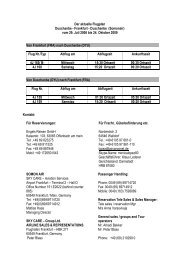dazu bitte hier klicken. - Botschaft der Republik Tadschikistan
dazu bitte hier klicken. - Botschaft der Republik Tadschikistan
dazu bitte hier klicken. - Botschaft der Republik Tadschikistan
Sie wollen auch ein ePaper? Erhöhen Sie die Reichweite Ihrer Titel.
YUMPU macht aus Druck-PDFs automatisch weboptimierte ePaper, die Google liebt.
LIFESTYLE<br />
50<br />
Von Einem,<br />
<strong>der</strong> auszog<br />
das Fürchten<br />
zu lehren<br />
Die Stadtführung durch<br />
das düster-romantische<br />
Berlin <strong>der</strong> Gotikzeit<br />
„Wer hat Angst vorm schwarzen<br />
Mann? Niemand? – Natürlich<br />
nicht. Wäre auch unsinnig, denn<br />
schließlich treibt viel mehr die<br />
,weiße Frau‘ in Berlin seit über vier<br />
Jahrhun<strong>der</strong>ten ihr Unwesen“,<br />
erklärt Historiker und Betreiber<br />
<strong>der</strong> Bärentouren Michael Bockau<br />
scherzend und eröff net seine samstägliche<br />
Gotik-Gruseltour an <strong>der</strong><br />
Marienkirche am Alexan<strong>der</strong>platz.<br />
The Man Who Goes<br />
Out to Teach the<br />
Meaning of Fear<br />
– a guided tour through the dark<br />
romantic Berlin of the Gothic age<br />
„Who’s afraid of the Bogeyman? Nobody? Well, of course<br />
not. It would make no sense anyhow as the creepy fi gure<br />
who has been stalking Berlin for four centuries is in<br />
fact a woman,” explaines the historian and operator of<br />
Bärentouren, Michael Bockau jokingly at the start of his<br />
spine-chilling Saturday Gothic tour of St. Mary’s Church<br />
near Alexan<strong>der</strong>platz.<br />
A few of the participants are won<strong>der</strong>ing who he on earth means<br />
when talking about by the “White Lady”. “Let’s take one thing<br />
at a time... after all, we are on a tour,” he replies pointing to the<br />
massive cross right in front of the church’s entrance. “First let’s<br />
see whether any of you today can make the church turn on its<br />
own axis.” The cross has fi ve holes. Anybody capable of placing<br />
all fi ve fi ngers into the grooves will activate a secret mechanism<br />
hidden in the sacred building dating back to the 13th century.<br />
The participants try in vain while the expert continues telling the<br />
story of Provost Nikolaus von Bernau who was beaten to death<br />
Informationen unter:<br />
Bärentouren<br />
Michael Bockau<br />
Weitere Informationen über die 27<br />
angebotenen Touren in Berlin und<br />
Umland unter:<br />
www.baerentouren.de<br />
Tel.: 030 – 46 06 37 88<br />
Einige Teilnehmer fragen sich,<br />
wen er wohl mit <strong>der</strong> „weißen<br />
Frau“ meint. „Alles <strong>der</strong> Reihe<br />
nach, schließlich machen wir ja eine<br />
Tour“, erwi<strong>der</strong>t er und zeigt auf ein massives<br />
Kreuz direkt vor dem Eingang <strong>der</strong><br />
Kirche. „Zuerst wollen wir mal schauen,<br />
ob heute jemand dabei ist, <strong>der</strong> es schaff t,<br />
dass sich die Kirche einmal um ihre eigene<br />
Achse dreht“. In dem Kreuz sind fünf<br />
Löcher ausgeformt. Wer seine fünf Finger<br />
in diese Kerben stecken kann, löst einen<br />
geheimen Mechanismus des sakralen<br />
Gebäudes aus dem 13. Jahrhun<strong>der</strong>t<br />
aus. Die Teilnehmer versuchen es, lei<strong>der</strong><br />
ohne Erfolg, während Experte Bockau<br />
die Geschichte von Probst Nikolaus von<br />
Bernau, <strong>der</strong> von Berliner Bürgern 1324<br />
<strong>hier</strong> vor <strong>der</strong> Kirche erschlagen wurde,<br />
erzählt. Er hatte die Bürger gescholten,<br />
weil sie trotz päpstlichen Verbots zu ihrem<br />
Markgrafen hielten.<br />
Es beginnt zu dämmern und die Gruppe<br />
um den Historiker beginnt den dreieinhalbstündigen<br />
Marsch, um Berlin<br />
von seiner dunkel-romantischen Seite<br />
kennenzulernen. Nach einem ersten<br />
Halt vorm Neptunbrunnen, nachdem<br />
auch die hartgesottenen Besucher<br />
verstehen, wieso bereits <strong>der</strong> preußische<br />
König darauf bestand, den Wasserherrscher<br />
so zu drehen, dass <strong>der</strong><br />
böse, angsteinfl ößende Blick nicht in<br />
Richtung des Schlosses zeigte, macht<br />
Bockau kurzen Prozess. Nicht ohne vorher<br />
über die verschiedenen Foltertorturen<br />
und Todesstrafen des Mittelalters<br />
aufzuklären, liest er aus Originalquellen<br />
von einem <strong>der</strong> letzten Schauverfahren<br />
vor dem heutigen roten Rathaus.<br />
Weiter geht es ins Nikolaiviertel, vorbei<br />
am Lessinghaus, dem Paddenkrug und<br />
<strong>der</strong> Nikolaikirche mit ihren geheimnisvollen<br />
heraldischen Abbildungen. Gespannt<br />
folgen die Besucher den düsteren<br />
Ausführungen und gespenstischen<br />
Anekdoten durch die Geschichte <strong>der</strong><br />
„verwunschenen Stadt in <strong>der</strong> Stadt“. Das<br />
Fürchten versucht Bockau <strong>der</strong> Gruppe vor<br />
<strong>der</strong> Gerichtslaube zu lehren. Detailliert erklärt<br />
er Strafen wie Rä<strong>der</strong>n, Aufknüpfen,<br />
Verstümmelungen o<strong>der</strong> die mittelalterlichen<br />
Hexenproben. Spätestens <strong>hier</strong> sind<br />
die meisten Teilnehmer froh, nicht im Mittelalter<br />
leben zu müssen.<br />
Mystisch geht es weiter. Wenige Meter<br />
neben <strong>der</strong> Gerichtslaube hält <strong>der</strong> Gotikfachmann<br />
vor einem alten Herrenhaus,<br />
einem Gebäude in dem Kurfürst Johann<br />
Georg Schutz vor <strong>der</strong> „weißen Frau“<br />
suchte. Der Kurfürst fürchtete sich vor<br />
<strong>der</strong> Rache <strong>der</strong> „schönen Gießerin“ Anna<br />
Sydow, einer Geliebten seines verstorbenen<br />
Vaters, die er einkerkern und<br />
sterben ließ. „Die ,weiße Frau‘ spukte<br />
im Stadtschloss und kündete von Unheil<br />
und Tod, war zuweilen aber auch<br />
Patronin des Hauses Hohenzollern und<br />
sah nach dem Rechten“, erklärt Bockau,<br />
während sich die kleine Gruppe an den<br />
ehemaligen Reitstellen <strong>der</strong> Schlossfreiheit<br />
vor zur alten Klosterruine nahe<br />
am Alexan<strong>der</strong>platz in Marsch setzt.<br />
Er erzählt von einer zweiten Theorie.<br />
Bei <strong>der</strong> „weißen Frau“ handele es sich<br />
um ein Gespenst, dass die Hohenzollern<br />
bereits aus Franken mit nach Berlin<br />
gebracht hatten, die Gräfi n von Orlamünde,<br />
die für ihren Kindsmord, um<br />
Albrecht den Schönen zu ehelichen,<br />
Buße tat an den Hohenzollern, ihnen<br />
ihre Seligkeit neidend.<br />
Mit Gründungslegenden von Berlin und<br />
weiteren dunklen Anekdoten über Mumien<br />
und Mediziner im Gepäck kommt<br />
die Gruppe an <strong>der</strong> gotischen Klosterruine<br />
an, um die Legende vom weinenden<br />
Mönch zu hören, die letzte Geschichte<br />
<strong>der</strong> Tour. „Wenn man ganz still ist, kann<br />
man den Geistlichen in stürmischen<br />
Nächten noch klagen hören“, meint<br />
Grusellehrer Michael Bockau. Auf hohe<br />
Windgeschwindigkeiten möchten die<br />
meisten Teilnehmer jedoch nicht warten<br />
und verlangen schmunzelnd und begeistert<br />
das Infoblatt mit weiteren Führungen<br />
durch die Hauptstadt, die <strong>der</strong> Historiker<br />
sicherlich ebenso liebevoll und<br />
spannend zusammengestellt hat. bb<br />
in front of the church by local citizens in 1324. He had rebuked<br />
the people because they had insisted on remaining loyal to their<br />
margrave despite the papal interdiction.<br />
Dusk is now falling, and the group follows the historian as he<br />
starts off on the three and half hour walk to experience Berlin’s<br />
dark romantic side. After the fi rst stop at the Neptune Fountain,<br />
where even the most hardened visitors un<strong>der</strong>stand why<br />
even the King of Prussia insisted on turning away the God of<br />
Water and the Sea so that its evil, scary<br />
look did not gaze upon the palace. Bockau,<br />
without beating around the bush, launches<br />
straight into an explanation of the diff erent<br />
methods of torture and capital punishment<br />
in the Middle Ages, reading from original<br />
transcripts of one of the last show trials that<br />
took place in front of today’s Red City Hall.<br />
Then on they continue to the Nikolai Quarter<br />
passing the Lessing House, the Paddenkrug<br />
and St. Nicholas’ Church with its mysterious<br />
heraldic fi gures. The visitors listen excitedly<br />
to the dark stories and eerie anecdotes from<br />
the history of the “execrated town within the town”. In front of<br />
the Gerichtslaube or old Court House Bockau tries to convey to<br />
the group exactly what fear is. In grisly detail he explains punishments<br />
such as breaking on the wheel, hanging, mutilation<br />
or the medieval witch tests. After having heard all this most of<br />
the participants are more than happy not to have had to live in<br />
those medieval times. The haunting tour continues. A few metres<br />
from the old Court House our expert stops in front of an old<br />
mansion where the Elector Johann Georg sought shelter from<br />
the “White Lady”. He feared the revenge of Anny Sydow, also<br />
known as “die schöne Gießerin” or beautiful caster, a mistress<br />
of his deceased father, who put her in prison where she later<br />
died. “The ‘White Lady’ who haunted the City Palace heralding<br />
misery and death was also, for a time, the patron of the House<br />
of Hohenzollern making sure that everything was kept in or<strong>der</strong><br />
there,” explains Bockau as the small group again begins to<br />
move along the former riding stables of Schlossfreiheit towards<br />
the ruins of an ancient monastery near Alexan<strong>der</strong>platz. While<br />
doing so he discusses an alternative theory. The “White Lady”<br />
was a ghost who came with the Hohenzollerns to Berlin from<br />
Franconia. The Countess of Orlamünde had mur<strong>der</strong>ed a child in<br />
or<strong>der</strong> to marry Albrecht the Fair, and so was condemned to do<br />
penance thus begrudging the Hohenzollerns their happiness.<br />
Packed with legends concerning the founding of Berlin and other<br />
dark anecdotes of corpses and early medical practitioners the<br />
group arrives at the ruined Gothic monastery to hear the legend<br />
of the weeping monk, the last saga of this tour. “If you are very<br />
quiet you can still hear him lamenting on stormy nights,” says<br />
our teacher of fear, Michael Bockau. But most of the guests do<br />
not want to wait for any high winds and smiling and deeply impressed<br />
ask for fl yers on other guided tours through the capital<br />
city that this historian will certainly arrange with that same eye<br />
for detail and thrilling tales. bb<br />
OKTOBER 2010 OKTOBER 2010<br />
51







